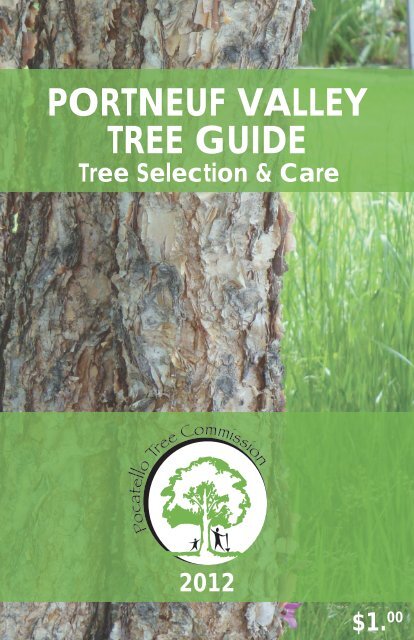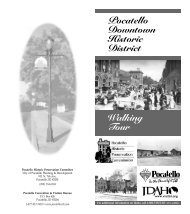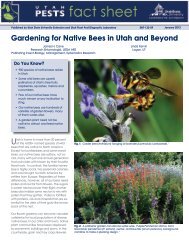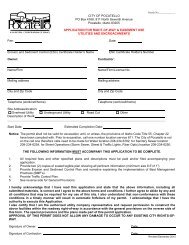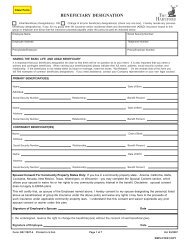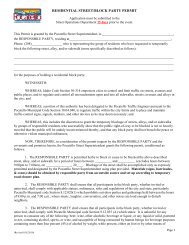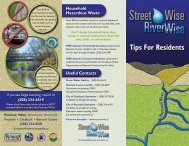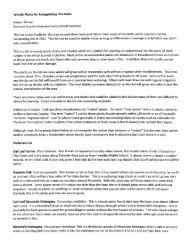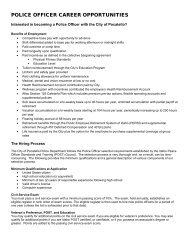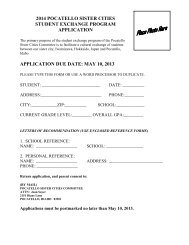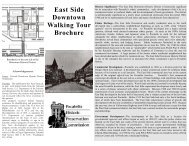PORTNEUF VALLEY TREE GUIDE - City of Pocatello
PORTNEUF VALLEY TREE GUIDE - City of Pocatello
PORTNEUF VALLEY TREE GUIDE - City of Pocatello
You also want an ePaper? Increase the reach of your titles
YUMPU automatically turns print PDFs into web optimized ePapers that Google loves.
TOWN & COUNTRYTown & Country Gardenswww.tcgardens.com1300 E. Oak Street<strong>Pocatello</strong> 232-79855800 S Yellowstone HwyIdaho Falls 522-5247TOP 5 REASONSTo Buy your Trees from Town & Country5. Our trees are “Climate Tested” for East Idaho4. Largest selection <strong>of</strong> trees3. Friendliest staff around2. 2 Year Guarantee on our hardy trees at no additional cost1. No one knows trees better
decline and die. Be sure to select trees that are well adapted to ouralkaline soils. Check with your county extension <strong>of</strong>fice for soil testinginformation (Bannock County 208-236-7310).2Maintenance: All trees need regular watering and periodic inspectionfor pests and disease. Broadleaf trees also need routine pruning.Carefully selecting a tree that is suited to the planting site will savetime and money.<strong>TREE</strong>S AND UTILITIESTree limbs and power lines are not a good combination—especiallywhen storms bring lightning, high winds, and ice. Utility companies trimtree limbs away from power lines to prevent power outages duringsevere weather. To prevent problems, choose utility-friendly trees fromthe “Small Trees” section, or contact cwestling@idahopower.com,208-736-3213/208-221-3128.Underground utility lines can easily be cut with a shovel, and youare legally and financially responsible if you damage them. Idaholaw requires that you call Digline, 1-800-342-1585, before digging.Employees <strong>of</strong> utility companies will mark locations <strong>of</strong> undergroundlines at no charge.S<strong>TREE</strong>T <strong>TREE</strong>SStreet trees are planted in the area between sidewalk and curb.This area is called the parking strip, and it is under city jurisdiction.Before You Plant
3<strong>Pocatello</strong>’s tree ordinance requires that tree branches be kept 8’above sidewalks; 12’ above streets; and 14½’ above designatedtruck routes. The ordinance and Master List <strong>of</strong> Acceptable Treesexplain requirements and prohibitions related to street trees. To seethem, visit <strong>Pocatello</strong> <strong>City</strong> Hall or www.<strong>Pocatello</strong>.us/pr/documents/acceptable_trees.BE FIREWISEFirewise practices include removing dead wood and low treebranches; removing vegetation from ro<strong>of</strong>s, gutters, and under decks;selecting fire-resistant plants; and keeping tree limbs 15’ away fromchimneys, buildings, and power lines. To learn more: www.firewise.orgor Three Rivers RC&D at 208-241-4656.PLANTING INSTRUCTIONSCare For Your TreesThe most common and serious planting error is planting too deep.Before planting, find the root flare—where roots spread at the base <strong>of</strong>the trunk. This flare should be partly visible at the top <strong>of</strong> the plantinghole.The most common planting stock found at local nurseries are incontainers, bareroot, or balled and burlapped (B&B). Plantingprocedures vary depending on the kind <strong>of</strong> stock selected. For a sturdytree, carefully follow these procedures:1. Dig hole 2 to 3 times as wide as the root-ball and the same depthas the tree was planted in the nursery. The sides <strong>of</strong> the hole should berough and uneven to help roots grow into the surrounding soil.Container Stock: Gently remove container and inspect root-ballfor circling roots. If you see only a few, gently separate and spreadthem outward. Eliminate masses <strong>of</strong> circling roots by making twoto four half-inch deep vertical cuts in the sides <strong>of</strong> root-ball. Cut ashallow “X” on the bottom <strong>of</strong> the root-ball. If soil covers the rootflare, brush it <strong>of</strong>f. Place root-ball in planting hole. Make sure top<strong>of</strong> root flare is level with or slightly higher than surrounding ground.Balled & Burlapped (B&B): If soil covers the root flare, brush it <strong>of</strong>f.Carefully place tree in planting hole so top <strong>of</strong> root flare is levelwith or slightly higher than surrounding ground. If you need toadjust tree’s position, shift the root-ball; do not twist tree trunk.Straighten tree and add just enough soil to stabilize it. Cut andremove all twine or wire. Remove as much burlap as possible, assome is not biodegradable.
4Care For Your TreesBareroot: Keep roots moist at all times! Remove damaged orbroken roots. Place tree in planting hole at the same depth thatit grew in the nursery. Do not let roots curl up or around hole. Holdtree straight while filling hole with soil. With your hands, gentlypush soil under and between roots to remove air pockets. If treesettles too deeply, gently pull it back to the proper depth.2. Stand back and inspect the tree from several sides to make sure it’sstraight. If it is not, adjust it. Add soil around roots until hole is half full.Lightly water to settle soil and remove air pockets. Gently tamp soil tocompress it around root-ball, taking care not to damage any roots.Add soil until hole is filled. Do not cover top <strong>of</strong> root flare with soil.3. Make a shallow basin to hold water around the roots. Fill the basinwith water several times, allowing it to soak into the root-ball betweeneach filling. Add soil where excessive settling occurs.4. Fill the basin with 2–3” <strong>of</strong> wood chips. Do not place wood chipsdirectly against the tree trunk, as this may promote trunk rot.5. Remove dead, broken, or crossing branches.6. Unless the site is windy, it is not necessary to stake the tree. Do stakeif the root-ball is fractured or the trunk is not stable. Remove stakesafter one year.HOW TO PLANT A <strong>TREE</strong>2/3 distance fromroot collar flare t<strong>of</strong>irst branchStakeIf necessary, stake the treewith wide, flat straps andattachments that allow itto move a little in thewind.Backfilled soilRoot collar flareDo not plant treelower than this.2 - 4 inches mulch2 - 5 times width <strong>of</strong> root ball
6Care For Your TreesOverfertilization can also contaminate groundwater or pollute nearbybodies <strong>of</strong> water. When applying nitrogen, choose slow-releaseformulas to reduce the chance <strong>of</strong> root burning, which some quickrelease,high-concentrate nitrogen fertilizers can cause. Naturalorganic forms <strong>of</strong> nitrogen are the best choices.Pruning improves structure and enhances vigor <strong>of</strong> mature or agingtrees. Dead, broken, or crossing branches should be pruned fromtrees <strong>of</strong> any age. Cut branches just outside the branch collar. Avoidmaking flush or stub cuts. Wound dressings are not necessary and mayimpede the tree’s natural healing process. For more information, or fora list <strong>of</strong> certified arborists, contact the city forester at 234-1895.PROPER PRUNING PRINCIPLESPests are insects, mites, bacteria, fungi, and viruses. Many organisms inthe landscape are considered pests because <strong>of</strong> the damage they door because their numbers are so large. Some <strong>of</strong> these organisms donot harm plants but are in fact beneficial to them and are a valuablepart <strong>of</strong> the ecosystem.Many pest problems result from improper watering, poor plant stock,or an inferior planting site. Trees that are poorly adapted to a site areusually most affected by pests. Choosing a tree that is well adaptedto the site will significantly reduce many pest problems.In selecting trees for this guide, we have chosen species that haveadapted well to our local environment. We have identified pestsassociated with some <strong>of</strong> these trees, but with proper attention tocorrect planting procedures, growing conditions, and maintenance,you will promote a tree’s best protection against pests: good health.
7Weeds and Herbicides do not belong near trees. To keep areasaround trees free <strong>of</strong> weeds and other competing plants, use woodchip mulch to suppress them, and remove them by hand whenpossible. Avoid using herbicides near trees as some formulationsseriously injure or kill them. If you do use them, avoid getting any onleaves, branches, trunks, or near roots <strong>of</strong> any plants you wish to keep.Some fertilizers contain weed killers; these weed-and-feed fertilizersshould not be used near tree roots. Remember that a tree’s rootsextend well beyond its outermost branches.<strong>TREE</strong> <strong>GUIDE</strong> LEGENDLIGHT REQUIREMENTFull Sun Part Sun Shade<strong>TREE</strong> SIZES AND FORMSHeight, width, and other characteristics are provided for specifictrees in the Recommended Trees section <strong>of</strong> this guide. The tree formspictured here are examples <strong>of</strong> crown shapes <strong>of</strong> mature trees. Seeinghow a tree will look will help you plan its inclusion in your landscape.Tree descriptions in this guide refer to these forms.spreading columnar vase pyramidalTree Guide Legendoval rounded irregular multistemHARDINESS ZONESUSDA Hardiness Zones are based on minimum winter temperatureranges throughout the U.S. A zone rating can help you select a treethat is cold hardy in your zone, but keep in mind that a cold-hardytree may not tolerate other conditions (soil, wind, low rainfall) in ourarea. Other cautions: different growers may assign different hardinesszones to the same species; groups other than the USDA have createdtheir own zone classifications, and their zone numbers do not meanthe same thing as the USDA’s.
Most <strong>of</strong> <strong>Pocatello</strong> falls into USDA Zone 5, with minimum temperatureranges <strong>of</strong> -20 to -20F. Contact your local extension <strong>of</strong>fice to find outyour area’s hardiness zone. A green ‘Z’ followed by the zone range isgiven for each tree in the tree selection section.AVAILABILITYLocal nurseries sell some <strong>of</strong> the trees recommended in this guide, butsome <strong>of</strong> the best trees for this area may have to be special ordered.When you place a special order, it may help you to know:• Almost all trees sold here are grown fairly far away. It is usuallynecessary to get your special order tree placed with a shipmentthat is already coming in or shipping expenses would be very high.• Just because growers have a certain tree in their catalogs doesnot mean that tree is always available. Tree availability is usuallybest in the fall and worst from April through July. The best time toorder your special tree is in the fall for next spring.• If you want a special order <strong>of</strong> a bareroot tree, be aware thatmost bareroot trees must be ordered in bundles. The nursery maynot want to order a bundle <strong>of</strong> 5 or 10 trees if you only want one.• When ordering special trees, don’t give up if they are not instantlyavailable. Give the retail nursery advance notice and plenty <strong>of</strong>time. If you want a special tree you probably already know it’s agreat tree, so don’t settle for a lesser substitute too quickly.Designations for availability <strong>of</strong> tree selections:readily = commonly availablerequest = nursery can special ordermail order = rarely available from nursery but available onlineseedling only = generally mail order as seedlings only8ORIGINNative to southeast Idaho and nearby regionsTree Guide Legend
9SMALLDECIDUOUS<strong>TREE</strong>SSmall trees can be planted under power lines and in smaller plantingareas, including 3’-wide parking strips. Space 15’–20’ apart.© Alissa SalmoreSmall Deciduous TreesBirch, WaterBetula occidentalisZ 3-7Mature size: 20’h x 20’wGrowth rate: slowAvailability: request© Bowpoint Nursery © Deborah JeppsonUsually multistemmed but can betrained to single trunk. Copperypeeling bark. Light greensummer leaves turn yellow in fall.Prefers moist sites but tolerant <strong>of</strong>somewhat dry conditions onceestablished. Resistant to borers.Good substitute for aspen.Attracts birds.Where to see:Banks <strong>of</strong> Mink& <strong>City</strong> Creeks;5120 Daisy.
Chaintree, GoldenLaburnum X watereri10Z 5-7Mature size: 12’h x 10’wGrowth rate: mediumAvailability: readilyClusters <strong>of</strong> yellow pealike flowersin long, hanging clusters becomehairy pods that persist throughwinter. Bright green leaves andolive green bark. Poisonous.Good planted in groups. Tolerant<strong>of</strong> our alkaline soils.Where to see:454 Yellowstone;275 McKinley.© Michael Kuhns© Michael KuhnsChokecherry, CommonPrunus virginianaZ 2-6Mature size: 20’h x 15’wGrowth rate: mediumAvailability: readilySmall white spring flowers produceclusters <strong>of</strong> edible black fruits. Thislarge shrub or small tree tendsto sucker but can be pruned tomaintain a tree form. Excellentchoice for wildlife plantings andwindbreaks. ‘Canada Red’ and‘Shubert’ are common cultivarswith purple-red leaves andtreelike form.Where to see: Hillside ravinesand Mink Creek.© Iowa State UniversitySmall Deciduous Trees
11CrabapplesMalus spp.Small Deciduous Trees© Joseph LaForest© <strong>City</strong> <strong>of</strong> PortsmouthZ 3-9Mature Size: 15–25’h x 15–25’wGrowth rate: medium to fastAvailability: readilyThis popular small tree isgenerally chosen by flower color,fragrance, and fruit’s color, size,and persistence (fruit clinging orfalling in winter). Consider fruit sizeand persistence when planting asstreet tree. Most modern cultivarshave persistent fruits; some havegood fall color. Excellent accentfor any area. Fruitless varietiesare available. Becomes moredrought tolerant at maturity.Fireblight and cedar–apple rustcan be problems.Recommended red-floweredcultivars include: ‘Adams’,‘Prairiefire’, ‘Pr<strong>of</strong>usion’, ‘IndianSummer’, ‘Strawberry Parfait’,‘Radiant’, ‘Cardinal’, ’Centurion’;‘Prairie Rose’ has no fruit.Recommended white-floweredcultivars include: ‘DonaldWyman’, ‘Harvest Gold’, ‘WhiteAngel’, ‘Jewelcole’, ‘Sargent’,‘Snowdrift’, ‘Sugar Tyme’,‘Narragansett’; ‘Spring Snow’and ‘Marilee’ have no fruit.Where to see: ‘Spring Snow’ (n<strong>of</strong>ruit) and ‘Jewelcole’ (persistentfruit) on Main in Old Town;‘Spring Snow’ at Bartz Field andWaterwise Garden by <strong>City</strong> Hall.
Dogwood, CornelianCherryCornus masZ 4-8Mature size: 15’h x 15’wGrowth rate: mediumAvailability: requestSmall yellow flowers cover baretwigs in early spring. Shiny greenleaves turn yellow; some formsturn red in fall. Small edible cherryredfruits by midsummer. Better inalkaline soils and poor conditionsthan other non-shrub dogwoods.Native to western Asia and southcentral Europe.12© Michael Dirr© whatgrowsthere.comElm, CamperdownUlmus glabra ‘Camperdownii’Z 4-7Mature size: 6–15’h x 6–15’wGrowth rate: slow to mediumAvailability: readilyThis grafted elm slowly developsa broad, flat head and has acontorted, weeping habit. Hardy;suffers more from drought thancold. Rough, sharply toothed darkgreen leaves are sharply serratedand asymmetrical. Significantproblems with scale insects andelm leaf beetle.Where to see: West side <strong>of</strong> TheGrapevine, 455 S. 5th.© Michael KuhnsSmall Deciduous Trees
13GoldenraintreeKoelreuteria paniculataZ 5-9Mature size: 20’ x 20’Growth rate: slow to mediumAvailability: readilyDevelops a uniform and roundedcrown with age. Rich greenleaves may turn yellow in fall.Showy upright clusters <strong>of</strong> smallyellow flowers cover the tree insummer and become paperygreen lanterns that turn yellowthen brown. Withstands drought,heat, wind, and dry, alkaline soils.Has grown well in <strong>Pocatello</strong> forover 40 years.© Michael Kuhns© Michael KuhnsWhere to see: 1480 and 1450Paramount.Hackberry, NetleafCeltis reticulataSmall Deciduous Trees© Alissa Salmore© A. BarraZ 5-9Mature size: 20’h x 15’wGrowth rate: slow to mediumAvailability: seedling onlyLeaves are light green and ratherrough, with netlike small veins.Found on dry, rocky foothills andcanyons. Good choice for a smalltree where water is limited. Birdseat its tiny red berries. Native inBannock County.Where to see: Portneuf Gap north<strong>of</strong> I-15 on Chinese Peak.
HawthornsCrataegus spp.14Z 3-8Mature Size: 15–25’h x 15–25’wGrowth rate: mediumAvailability: readilyMost hawthorns are small, densetrees with white or pink springflowers and red clusters <strong>of</strong> berriesthat persist through the winter.Several are well adapted to ourarea; only River Hawthorn (C.rivularis) is native. Most havethorns, some more wicked thanothers. Good varieties for ourarea: Cockspur (C. crusgallivar. inermis); River (C. rivularis);Glossy (C. nitida); Winter King(C. viridis ‘Winter King’); Lavalle(C. X lavallei); Crimson Cloud(C. laevigata ‘Crimson Cloud’).Cockspur and ‘Crimson Cloud’are thornless.© Michael KuhnsWhere to see: Lavalle at corners<strong>of</strong> Main in Old Town; banks <strong>of</strong>Mink& <strong>City</strong>Creeks.© BYU Grounds StaffSmall Deciduous Trees
15Hophornbeam,AmericanOstrya virginianaZ 3-9Mature size: 25’h x 20’wGrowth rate: slowAvailability: requestGraceful, pyramidal when young,becomes rounded with age.Gray, flaking bark adds winterinterest. Wormlike yellow-greencatkins become pale yellowhop-like fruit. Dark green sharplyserrated leaves turn yellow-brownin fall. Good street tree. Toleratesalkaline soils. Nativeto eastern U.S.© Paul Wray© MichaelKuhnsSmall Deciduous TreesLilac, Japanese TreeSyringa reticulataZ 3-7Mature size: 20’h x 15’wGrowth rate: mediumAvailability: readilyExcellent specimen and streettree. Clusters <strong>of</strong> creamy whiteflowers stand out against darkgreen leaves. Red-browncherrylike bark. Tolerant <strong>of</strong>alkaline soils, drought, andpollution. Easily pruned to treeform. Cultivars ‘Ivory Silk’ and‘Summer Snow’ have round,compact crowns; ‘Regent’has an upright form.Where to see: <strong>Pocatello</strong> H.S.parking lot on N. Arthur; 1455Chokecherry Dr.
Lilac, PekingSyringa pekinensisZ 4-7Mature size: 20’h x 15’wGrowth rate: mediumAvailability: requestSimilar to Japanese tree lilacbut more finely textured. Largehoney-scented creamy whiteflower clusters. Tolerates widerange <strong>of</strong> conditions and soils.Fairly heat and drought tolerantonce established. Useful as asmall shade or street tree.16Where to see: Parking lot <strong>of</strong>Federal Courthouse.© Powell GardensMaackia, AmurMaackia amurensisZ 3-7Mature size: 20’h x 20’wGrowth rate: slowAvailability: requestWhite pealike flowers in uprightclusters become flat pods. Leavesopen with gray sheen then turnrich green. Shiny, amber barkpeels with age. Lower branchestend to droop so early pruning isimportant if used as a street tree.An excellent, neat tree for streets,lawns, and patios. Seems to dobetter when planted from smallersizes. Native to northeasternChina.Where to see: Barton & S. 5th.© Michael KuhnsSmall Deciduous Trees
17© Michael KuhnsMaple, Bigtooth/CanyonAcer grandidentatumZ 4-7Mature size: 20’h x 20’wGrowth rate: mediumAvailability: readilyNative, tolerant <strong>of</strong> droughtand alkaline soils, few diseaseor insect problems, windfirm,and strong wooded. Poorchoice for irrigated lawns.Great fall color <strong>of</strong>ten turns ourhillsides orange, yellow, andred. Flaking gray bark addswinter interest. Plant singly orin a grove. Species has bettercolor than cultivar ‘Rocky Mt.Glow’. Where to see: Hillsideravines; <strong>City</strong> Creek; Humboldt& 4th; Waterwise Garden by<strong>City</strong> Hall.Maple, HedgeAcer campestreSmall Deciduous Trees© Willow © Michael DirrZ 4-8Mature size: 25’h x 25’wGrowth rate: slowAvailability: requestDark green leaves usuallycling late into fall with sporadicyellow color. Resembles asmall, dense Norway maple.Tolerant <strong>of</strong> urban conditionsincluding poor, dry, alkalinesoils. Can be pruned into ahedge. A good street andyard tree that casts denseshade.Where to see: ISUbetween Admin. &Engineering Bldgs.;Goody’s at 905 S. 5th.
Maple, Rocky Mtn.Acer glabrumZ 3-7Mature size: 20’h x 20’wGrowth rate: mediumAvailability: request, mail orderVariable form with reddishspreading branches. At leasttwo varieties are native to ourmountains. Dark green leaveswith paler undersides turn yellowto muted red in fall. Red twigs,buds, and reddish winged seedsprovide winter interest. Very easyto train as single-stemmed tree.Where to see: Shadyslopes throughout ourmountains; SW cornerISU Quad.© Montana State University18Maple, ShantungAcer truncatumZ 4-8Mature size: 20’h x 20’wGrowth rate: slowAvailability: requestGlossy green leaves emergereddish and turn yellow-orangeto red in fall. Bright yellow flowersopen before leaves in spring.Tolerates dry, alkaline soils. Pestand disease resistant. Its largeleaves and regular branchingmake it an excellent shadeand lawn tree for smallspaces. Native to China.© John Ruter© Michael KuhnsSmall Deciduous Trees
19Maple, TatarianAcer tataricumZ 3-8Mature size: 20’h x 20’wGrowth rate: mediumAvailability: readilyBright green leaves with paleundersides turn yellow or red infall. Showy red inch-long wingedseeds in late summer. Similar toAmur maple but better adaptedto our alkaline soils. Good forsmall spaces. ‘Rugged Charm’,‘Pattern Perfect’, and ‘Hot Wings’are superior varieties and moretreelike than the species.Where to see: ‘Hot Wings’by ISU Rendezvous Bldg.© Vanessa Richins© Michael DirrMayday TreePrunus padusSmall Deciduous Trees© Michael KuhnsZ 3-6Mature size: 25’h x 20’wGrowth rate: medium to fastAvailability: readilyOne <strong>of</strong> the first trees to bloom inspring; fragrant clusters <strong>of</strong> whiteflowers emerge soon after thefirst leaves. Bright, bronzy greenleaves mature to dark green thenturn yellow to bronze in fall. Birdslove its astringent black cherries.Related to chokecherry, buttaller, more treelike, and does notsucker. Showy, adaptable treefor small spaces. ‘Merlot’ and‘Summer Glow’ have red leaves.Where to see: Clark & 5th at Kicks66; Fredregill & 4th.
Mtn. Mahogany, CurlleafCercocarpus ledifoliusZ 4-9Mature size: 20’h x 10’wGrowth rate: mediumAvailability: requestA native broadleaf evergreen!Shiny, narrow, deep greenleathery leaves contrast with lightgray bark. Feathery, twisting seedsresembling bent pipe cleanersadd summer interest. Can begrown as a small multistemmedtree or as a medium clippedhedge. Sun and heat tolerant.Where to see:Gibson Jacktrails; near ISUNatural HistoryMuseum.© Michael KuhnsOak, GambelQuercus gambelii© Alissa Salmore20Z 4-8Mature size: 20’h x 15’wGrowth rate: slow to mediumAvailability: requestNative as far north as CacheValley, UT. Size and crown vary inresponse to growing conditions:some are treelike; others formthickets from root sprouts. Shinygreen leathery leaves with palerundersides turn orange-yellowto brown in fall. Small acornsappear in late summer. Veryuseful in xeriscapes and nativelandscapes.Where to see: Shrub at WaterwiseGarden by <strong>City</strong> Hall; tree at entry<strong>of</strong> 1450 Juniper Hill Rd.© BYU Grounds StaffSmall Deciduous Trees
21Plum, PurpleleafPrunus cerasiferaZ 4/5-8Mature size: 18’h x 18’wGrowth rate: mediumAvailability: readilyThe purple-leaved cultivar‘Newport’ is common in<strong>Pocatello</strong>. Light pink flowers andpurple-green to dark purpleleaves. When mature, it developsan edible, dark purple fruit. A verypopular and useful tree here.Where to find: In front <strong>of</strong> <strong>City</strong> Hall.© Tom DeGomez© Joseph DiTomasoPlum, Princess KayPrunus nigra ‘Princess Kay’Small Deciduous Trees© University <strong>of</strong> MinnesotaZ 2-6Mature size: 15’h x 12’wGrowth rate: medium to fastAvailability: requestSelection <strong>of</strong> the native Canadaplum. Fragrant double whiteflowers open before leaves andremain longer than other plums.Dark green leaves turn red-orangein early fall. Shiny black bark addswinter interest. Exceptionally coldhardy and adaptable but needsgood drainage and consistentmoisture. Excellent accenttree, particularly against a darkbackground.Where to see: On N. 7th, north <strong>of</strong>Black Swan Inn.
Redbud, EasternCercis canadensis22Mature size: 20’h x 25’wGrowth rate: medium to fastAvailability: readilyMagenta buds cover brancheswith rosy-pink pea-like blossomsbefore leaves appear; bronze tored-purple heart-shaped leavesturn dark blue-green and mayturn yellowish in fall. In summerflat seedpods appear. Lowbranchingor multistemmed.Excellent small specimen tree.Adaptable, but susceptible toverticillium wilt in overwateredlawns. Native to eastern U.S.Where to see: NE 10th & Carter,344 S. 12th, 525 Washington.ServiceberryAmelanchier spp.Z 4-9Z 2-9Mature size: 6–20’h x 4–10’wGrowth rate: slow to mediumAvailability: readilyMay be shrub or tree. Delicatewhite blossoms. Red to deeppurple berries attract wildlife.Leaves open hairy gray-greenthen turn medium green. Mosthave good yellow, orange,or red fall color. Adaptableand tolerates a wide range <strong>of</strong>conditions. Shrubby A. alnifoliaand A. utahensis native to Idaho;nonnative tree forms sometimeschlorotic in local alkaline soils.Where to see: Area hillsides; ISUNatural History Museum.© Richard WebbSmall Deciduous Trees
23Smoketree, AmericanCotinus obovatusZ 4-8Mature size: 20’h x 20’wGrowth rate: mediumAvailability: requestBillowy hairs cling to flowerclusters and turn purplish pink insummer, covering the tree withsmokelike puffs. Blue-green leaves<strong>of</strong>fer excellent yellow, orange,red, or purple fall color. Grayblackflaky bark resembles fishscales. Excellent planted singlyor in masses. Native to Missouri.Tree-form ‘Grace’ hybrid <strong>of</strong>tenavailable.© Michael KuhnsSumac, StaghornRhus typhinaSmall Deciduous Trees© Ladislav Micek © Derek RamseyZ 3-8Mature size: 15’h x 15’wGrowth rate: fastAvailability: readilyA large shrub or small treethat suckers to form colonies.Large leaves turn brilliant red infall. Pyramidal clusters <strong>of</strong> fuzzyred-brown fruit (staghorns)attract wildlife. Staghorns andpicturesque branching addwinter interest. Good for massingand naturalized areas.Where to see: <strong>Pocatello</strong> H.S.parking lot on N. Arthur; 19th &Bonneville; 4940 Johnny CreekRd.; Waterwise Garden by <strong>City</strong>Hall.
MEDIUMDECIDUOUS<strong>TREE</strong>S24Medium trees are mainly planted for shade and general landscapeuses, including in 4–6’-wide parking strips. Space 20–30’ apart.© Alissa SalmoreAlder, EuropeanAlnus glutinosaZ 3-7Mature size: 40’h x 20’wGrowth rate: fastAvailability: requestSmall, plump catkins in spring turnto cones by summer and remainthrough winter. Dark green roundleaves with prominent veins.Tolerant <strong>of</strong> fairly dry, infertile soils;can endure some standing water.May sucker from roots to formthickets; used to control erosionon unstable sites. Cultivars includecut-leaved and compact forms.Smaller A. tenuifolia is native.Where to see: SE corner <strong>of</strong> OMNIBldg. at 275 S. 5th; A. tenuifoliaMink & <strong>City</strong> Creeks.© Jean-Pol GrandmontMedium Deciduous Trees
25Beech, European ColumnarFagus sylvatica ‘Dawyckii’ or‘Fastigiata’© BYU GroundsZ 4-7Mature size: 30’h x 8–10’wGrowth rate: mediumAvailability: requestNarrow, dense, rigidly uprightcrown can branch to the ground.Lustrous dark green leaves withlight green undersides may turnyellow in fall. Distinctive long,pointed buds. Smooth gray bark.Seeds borne in bristled husks.Gold- and purple-leaved varietiesavailable. Very effective in rowsand narrow planting areas. Doesnot like wet or compacted soils.Where to see: ISU Holt Arena.Birches, White-barkedBetula spp.Medium Deciduous Trees© Joseph O’Brian© Richard WebbZ 4-7Mature size: 25–40’h x 20–30’wGrowth rate: medium to fastAvailability: readily or requestWeeping white birch is popularbut very susceptible to borerinsects that can quickly kill trees.Varieties with attractive whitebark and resistance to borerinsects include: ‘Avalanche’,‘Dakota Pinnacle’, ‘Prairie Vision’,‘Prairie Dream’, ‘Renaissance’,‘Rocky Mountain Splendor’,and ‘Whitespire Senior’. Goodreplacements for aspen, whichhave their own serious problems.Where to see: Stanford & Yale.
Boxelder, SensationAcer negundo ‘Sensation’26Z 2-9Mature size: 35’h x 30’wGrowth rate: medium to fastAvailability: readilyA cultivar <strong>of</strong> our native boxelder,‘Sensation’ has a more controlledgrowth, improved branchstructure, and more uniformcrown. Medium green leavesturn red in fall. Green to redbrownstems. ‘Sensation’ doesn’tproduce fruit. Very tolerant <strong>of</strong>harsh conditions. The species isnot recommended; it has weakwood and poor branch structure.Where to see: Taysom Park; HoltArena south parking lot behindISU Education Bldg.© Michael KuhnsBuckeye, OhioAesculus glabraZ 3-7Mature size: 30’h x 20’wGrowth rate: mediumAvailability: requestOne <strong>of</strong> the first trees to leaf outin spring. Leaves emerge lightgreen and deepen to dark greenthen orange to red-brown in fall.Upright pyramidal clusters <strong>of</strong>yellow-green flowers becomeprickly, leathery husks that opento reveal shiny brown seeds(buckeyes). Branches begin lowon the trunk, swooping down andthen upward. Hardy and droughttolerant.Where to see: ISU west <strong>of</strong> Educ.Bldg.; 1642 Monte Vista.© Michael Kuhns© Michael KuhnsMedium Deciduous Trees
27Cherry, SargentPrunus sargentiiZ 4-7Mature size: 30’h x 30’wGrowth rate: mediumAvailability: readilyClusters <strong>of</strong> rich pink flowers openbefore leaves and are followedby very small purple-black fruitin June. Dark green leaves turnbronze in autumn. Glossy redbrownbark. Excellent specimentree. Many cultivars, includingcolumnar forms, are available.One <strong>of</strong> the most reliable trees forfall color.Where to see: On corners <strong>of</strong> Mainin Old Town.Chokecherry, AmurPrunus maackiiMedium Deciduous Trees© Bruce Marlin© Michael KuhnsZ 2-6Mature size: 25’h x 25’wGrowth rate: mediumAvailability: requestFragrant white flower clusters inspring. Small red fruits mature toblack in late summer, attractingbirds. Medium green leavesturn yellow-green in fall. Glossyamber to reddish-brown, peeling,shaggy bark for winter interest.Prune to single or multistem tree;remove interior branches to opencrown. Best in cold climates. Doesnot like excessive heat. Good aspatio, street, and specimen tree.Where to see: Marshall Library; NEcorner <strong>of</strong> Holt Arena.
Corktree, AmurPhellodendron amurenseZ 3-8Mature size: 35’h x 35’wGrowth rate: mediumAvailability: requestExcellent, picturesque tree for thisarea. Boldly branched, spreading.Corky, gray-brown bark. Darkgreen leaves turn yellow in fall.Yellow-green flower clusters fromMay into June. Females producecopious, messy pea-sized blackfruit that animals love. Fruitlessmale cultivars are ‘His Majesty’,‘Macho’, ‘RNI 4551’. Tolerant <strong>of</strong>urban conditions and poor, dry,alkaline soils. Plant in large openspaces that can accommodatethe low, wide branches.© Michael Kuhns28Elm, LacebarkUlmus parvifoliaZ 5-9Mature size: 40’h x 40’wGrowth rate: fast to mediumAvailability: requestA superior shade and street tree.Highly resistant to Dutch elmdisease and elm leaf beetle.Upright, spreading crown anduniform branching. Dark greenleaves may turn yellow to deepred in fall. Exfoliating multicolorbark. Very adaptable to soil andclimate extremes. Seedlings <strong>of</strong>the species vary in size, so choosecultivars. ‘Frontier’ has good fallcolor and no fruit.Where to see: 1552 S. 4th; ISUEngineering Complex at S. 2nd.© Karan A Rawlins© DaderotMedium Deciduous Trees
29Filbert, TurkishCorylus colurnaZ 4-7Mature size: 40’h x 20’wGrowth rate: mediumAvailability: requestExcellent for this area. Strongcentral trunk, symmetricalbranching, pyramidal form.Yellow male catkins emerge inspring and hang in clusters. S<strong>of</strong>tlyhairy leaves may turn yellow topurplish-red in fall. Nuts grow inclusters within thick, spiny husks.Flaky buff and pale gray bark.Does not sucker like other filberts.Very tolerant <strong>of</strong> urban sites anddry, alkaline soils. Plant singly or ingroups.Where to see: ISU Liberal Arts Bldg.GinkgoGinkgo bilobaMedium Deciduous Trees© Jan Samanek© Jan SamanekZ 3-9Mature size: 40’h x 30’wGrowth rate: slow to mediumAvailability: readilyUnique fan-shaped leaves turnbright yellow in fall. Gaunt, openform when young but later full andpicturesque. Fruit from femaletrees is messy and smelly, so plantmale clones ‘Autumn Gold’ or‘Princeton Sentry’. Practicallypest free, tolerant <strong>of</strong> poor, drysoils, air pollution, heat, drought,and cold. Excellent park or lawntree. Casts light shade.Where to see: ‘Autumn Gold’ onMain; ‘Princeton Sentry’ on ArthurAve.; Prehistory Park.
Hornbeam, EuropeanCarpinus betulusZ 4-7Mature size: 40’h x 40’wGrowth rate: slowAvailability: readilyA neat, uniform tree. Good asa single specimen, a screen,a hedge, or in groups. Catkinsappear in spring. Deep green,strongly ribbed leaves hold lateinto the fall when they may turnyellow. Small nutlets with leaflikeprojections hang in chainlikeclusters. Smooth gray bark isa bonus in winter. Cultivarsinclude ‘Fastigiata’ (narrow),‘Globosa’ (oval), and ‘Pendula’(weeping).Where to see: ISU RendezvousBldg.Horsechestnut, RedAesculus X carnea© Michael Kuhns© Michael Kuhns30Z 4-8Mature size: 35’h x 35’wGrowth rate: mediumAvailability: readilyA superior hybrid <strong>of</strong> horsechestnutand red buckeye. Roundedcrown has stout, close-knitbranches that make a densecanopy. Dark green leaves. InMay, large pyramidal clusters<strong>of</strong> rose-red flowers cover thetree. Prone to leaf scorch in latesummer. Adaptable to dry soilsbut best on moist, well-drainedsites.Where to see: Seefrom Benton in 488S. 7th backyard.© Michael Kuhns© Michael KuhnsMedium Deciduous Trees
31© Matthieu Sontag© Petr FillippovLinden, CrimeanTilia X euchloraZ 3-7Mature size: 40’h x 20’wGrowth rate: mediumAvailability: requestS<strong>of</strong>tly pyramidal when young,oval with age. Graceful, withsymmetrical branching. Shinygreen leaves may turn yellowin fall. Small yellow flowers inmidsummer become small hardnutlets with leafy bracts. Tolerant<strong>of</strong> urban conditions includingpoor, alkaline soils. Suckers shouldbe removed. A fine, graceful parktree where branches are allowedto touch the ground.Where to see: Near Ross Parkbaseball fields.Linden, LittleleafTilia cordataMedium Deciduous TreesZ 3-7Mature size: 40’h x 25’wGrowth rate: mediumAvailability: readilyExcellent lawn or street tree. Heartshapeddark green leaves mayturn yellow in fall. Small fragrantyellow flowers attract bees.Sensitive to road salts; prone togirdling roots and sunscald. Thinbarkedyoung trees need extrawater until very well established.Perhaps overplanted here.Good cultivars are ‘Glenleven’,‘Greenspire’, and ‘Chancellor’.Where to see: Satterfield Dr.;Simplot Square at Arthur &Center.
Maple, NorwayAcer platanoides32Z 3-7Mature size: 30’h x 30’wGrowth rate: mediumAvailability: readilyThe most well-known maple. Darkgreen leaves cast dense summershade and may turn bright yellowin autumn. Tolerant <strong>of</strong> climateand soil extremes. A few <strong>of</strong> themany cultivars are ‘Crimson King’(dark red leaves), ‘Deborah’(upright crown, red spring leavesturn green), ‘Emerald Queen’(oval crown, yellow fall color),‘Columnare’ (~15’ wide, smallerleaves), ‘Schwedler’ (red springleaves turn green). Where to see:‘Schwedlers’ on Carter by ISU.Maple, Norwegian SunsetAcer platanoides X truncatum ‘Keithsform’Maple, Pacific SunsetA. platanoides X truncatum ‘Warrenred’Z 4-8Mature size: 30–35’h x 25’wGrowth rate: fast to mediumAvailability: readilyHybrids <strong>of</strong> Norway and Shantungmaples. Upright, symmetricalbranches. Glossy dark greenleaves turn red, orange, yellowwhen fall is long or dry. Moreheat and drought tolerant thanparents. ‘Pacific’ smaller andmore delicate than ‘Norwegian’.Where to see: Holt Arena northparking lots; ISU Rendezvous Bldg.© <strong>City</strong> <strong>of</strong> Coeur d’Alene© Michael DirrMedium Deciduous Trees
33Maple, SycamoreAcer pseudoplatanusZ 4-7Mature size: 40’h x 30’wGrowth rate: mediumAvailability: requestPatchy outer bark flakes to exposeorange-brown inner bark. Coarsedark green leaves with whitishundersides. Small, yellow sweetsmellingflowers turn into wingedseeds. Adaptable, tolerant <strong>of</strong>air pollution, heat, alkaline soils,and fairly drought tolerant. Goodshady street tree where plantingstrips are at least 6’ w.Where to see: ISU Liberal ArtsBldg.; 233 S. Lincoln; 211 S. 2nd.Oak, Columnar EnglishQuercus robur ‘Fastigiata’ or ‘Skyrocket’Medium Deciduous Trees© Michael Kuhns © Michael KuhnsZ 4-8Mature size: 40’h x 10–15’wGrowth rate: medium to fastAvailability: readilyTall slender tree with deepgreenish-blue leaves. Acorns.Tolerant <strong>of</strong> fairly dry, alkaline soils.Bronze fall leaves may cling intowinter. Strong limbed and longlived. Excellent replacement forshort-lived Lombardy or Bolleanapoplars. ‘Skymaster’ may retain anarrower crown than ‘Fastigiata’.Where to see: 341 S. 7th;ISU on Cesar Chavez.
Pagodatree, JapaneseSophora japonica34Z 5-9Mature size: 35’h x 30’wGrowth rate: fast to mediumAvailability: requestA wide, spreading tree thatcasts light shade. Lustrous greenleaves. Creamy-white pealikeflowers bloom in clusters. Greenseedpods turn brown and clingto the tree into winter. Tolerant <strong>of</strong>urban conditions and poor, drysoils. Excellent specimen or shadetree for parks and large yards.‘Regent’ is the cultivar <strong>of</strong> choice.Where to see: ISU EducationBldg.; 13th & Bonneville.© Michael KuhnsPear, CalleryPyrus calleryanaZ 4-9Mature size: 30’h x 20’wGrowth rate: fastAvailability: readilyPopular ornamental. Pr<strong>of</strong>usewhite blossoms in spring followedby glossy green leaves that turnbrilliant shades <strong>of</strong> red and purplein fall. Inconspicuous hard, peasizedfruit. Very tolerant <strong>of</strong> heat,drought, and compacted soils.May turn chlorotic in heavilyirrigated lawns. Some commonvarieties in <strong>Pocatello</strong>: somewhatnarrow ‘Chanticleer’, very narrow‘Capitol’, broader ‘Aristocrat.’Where to see: Main & Arthur inOld Town; Fred Meyer parking lot.© Michael Kuhns© Michael KuhnsMedium Deciduous Trees
35YellowwoodCladrastis lutea/kentukeaZ 4-8Mature size: 30’h x 35’wGrowth rate: mediumAvailability: requestBroad, low-branching crown iscovered with drooping, pyramidalclusters <strong>of</strong> fragrant white flowersin early summer. Silky hairs covernew leaves, which mature topea-green then turn yellow in fall.Brown seedpods. Smooth graybark is a plus in winter. Toleratesalkaline and dry soil. Excellentspecimen tree. ‘Rosea’ has pinkflowers.© Vanessa Richins © Michael DirrWhere to see: TaysomPark.Zelkova, JapaneseZelkova serrataMedium Deciduous Trees© Richard WebbZ 5-8Mature size: 35’h x 30’wGrowth rate: fastAvailability: readilyUpright and spreading crown isdistinctly vaselike. Dark greenleaves turn yellow, bronze, andred-purple in fall. Lightly flakinggray-brown bark and orangeinner bark. Tolerant <strong>of</strong> heat anddrought. Good cultivars are‘Green Vase’ and ‘Village Green’.An excellent street and parktree for its relative neatness, lightshade, and quick growth. Goodsubstitute for American elm.Where to see: 620 S. 8th; Main &Arthur in Old Town.
LARGEDECIDUOUS<strong>TREE</strong>SLarge trees can be long lived. When selecting a tree from this group,be sure that the site has ample room to accommodate it at maturity.Plant in open areas or in planting strips wider than 6’. Space 30–50’apart.36Ash, GreenFraxinus pennsylvanicaZ 3-9Mature size: 50’h x 40’wGrowth rate: medium to fastAvailability: readilyAn extremely hardy tree thatgrows under many conditions.Shiny green leaves turn yellow inautumn. Seed can be a nuisance.Subject to several insect anddisease problems; borers are themost serious. Overplanted buttough. Choose male cultivars.Some recommended varieties:‘Bergeson’, ‘Marshall’, ‘Patmore’,and ‘Urbanite’.Where to see: Commonin town; SE corner <strong>of</strong>Terry & Princeton.© Richard WebbLarge Deciduous Trees
37Ash, WhiteFraxinus americanaLarge Deciduous Trees© Richard WebbZ 3-9Mature size: 60’h x 40–60’wGrowth rate: mediumAvailability: readilyUpright oval crown becomesrounded at maturity. Leaves turnyellow to reddish purple in fall.Gray-brown bark is tightly ridgedin diamond shapes. Superiorto more commonly plantedgreen ash. ‘Autumn Purple’is an excellent cultivar withdependable red-purple fall color.Native <strong>of</strong> eastern North America.Subject to borer insects.Where to see: ISU parking lot south<strong>of</strong> Holt Arena.Beech, EuropeanFagus sylvaticaZ 3-9Mature size: 50’h x 40’wGrowth rate: medium to slowAvailability: readilyLong-lived. Wide, stately canopy.Leaves cast dense shade andturn reddish bronze in fall.Smooth gray bark. Nuts form ina prickly shell. Good on alkalinesoils but needs adequate water.‘Riversii’ (coppery-green leaves);‘Atropunicea’ or ‘Purpurea’ (darkpurple leaves); smaller ‘Tricolor’and ‘Roseomarginata’ (leavesedged in pink and cream);‘Pendula’ (weeping form).Where to see: ‘Riversii’ at TaysomPark; ‘Pendula’ at ISU College <strong>of</strong>Business; ‘Purpurea’ 551 S. Duke.
Buckeye, YellowAesculus flava38Z 4-8Mature size: 50’h x 40’wGrowth rate: mediumAvailability: requestMedium green leaves turnorange-red in fall. One <strong>of</strong> our besttrees for fall color. Yellow flowerspikes appear in spring. Fruitis a smooth, rounded capsuleholding brown seeds (buckeyes).Gray and brown bark has largeflat plates and scales on oldtrunks. Less troubled by leafdiseases than other buckeyesand horsechestnuts.Where to see: 242 S. 7th byPresbyterian church, next tohorsechesnuts for comparison.© Michael Dirr© John SwintoskyCatalpa, NorthernCatalpa speciosaZ 4-9Mature size: 60’h x 30’wGrowth rate: moderately fastAvailability: readilyPerhaps the last tree to leaf outin spring. Large heart-shapedleaves, snowy white flower clusters,and dangling winter seedpods<strong>of</strong>fer year-round interest. Veryhardy and adaptable. Can getchlorotic in overwatered lawns.Native in small area <strong>of</strong> Midwest;naturalized throughout easternand midwestern U.S.Where to see: 1352 E. Center.© Michael KuhnsLarge Deciduous Trees
39C<strong>of</strong>feetree, KentuckyGymnocladus dioicusZ 3-8Mature size: 60’h x 40’wGrowth rate: mediumAvailability: requestA very fine shade tree for our area.Leaves emerge reddish, turnblue-green in summer, then paleyellow in fall. Inconspicuous butfragrant male and female flowerson separate trees. Thick seedpodscling to coarse branches throughwinter. Extremely hardy. Excellentfruitless male cultivars are‘Espresso’ and ‘Stately Manor’.Where to see: On Bonnevillebetween Garfield & Arthur; RossPark near horseshoe courts.Elm, HybridUlmus X hybridaLarge Deciduous Trees© BYU Grounds StaffZ 4-7Mature size: 45–70’h x 30–50’wGrowth rate: medium to fastAvailability: requestSome <strong>of</strong> the best large trees forthis area. These are NOT poorquality Chinese/Siberian elms.Resistant to Dutch elm disease,drought tolerant, vigorous, andgood shade trees. ‘Pioneer’,‘Vanguard’,‘Homestead’,‘Sapporo Autumn Gold’,‘Accolade’, ‘Regal’, and‘Discovery’.Where to see: Bannock CountyFairgrounds; ‘Homestead’ atBonneville Community Center,426 N. 6th.
Hackberry, CommonCeltis occidentalisZ 4-7Mature size: 50’h x 40’wGrowth rate: medium to fastAvailability: readilyTough; should be planted heremore <strong>of</strong>ten. A bit hard to establishbut tolerates low temperaturesand wind. Pyramidal in youth butdevelops a broad arching crownwith ascending branches. Corkyridged gray bark and sweetorange-red, pea-sized fruits. Lightto medium green leaves can becovered with nipple gall; witchesbrooms may develop.Where to see: ISU SE <strong>of</strong> Holt Arena;south side ISU Quad by PharmacyBldg.; 356 S. 8th.Honeylocust, ThornlessGleditsia triacanthos var. inermis© Michael Kuhns© Michael Kuhns40Z 4-9Mature size: 30–60’h x 30–50’wGrowth rate: fastAvailability: readilyA hardy, finely textured tree thatlets sunlight filter through. Goodyellow fall color but leaves dropearly. Flat brown seedpods canbe messy, but are rare on seedlessvarieties. Drought resistant andtolerates diverse soil conditions;diseases and insects can beproblems. Cultivars ‘Majestic’,‘Moraine’,‘Shademaster’,‘Imperial’, and ‘Skyline’ aresuperior to thorny species.Where to see: Common in town;208 S. 19th; ISU Biology Bldg.© Tom DeGomezLarge Deciduous Trees
41HorsechestnutAesculus hippocastanumZ 3-8Mature size: 50’h x 40’wGrowth rate: mediumAvailability: readilyUpright clusters <strong>of</strong> white flowerswith blotches <strong>of</strong> yellow to red inspring. Flowers become greenspiny balls that split open toexpose brown nuts with paleeyes. Large deep green leaves.Best reserved for parks and largeyards. Leaf scorch is a problem.Native to southeastern Europebut well adapted to our climateand soils. Cultivar ‘Baumannii’ isdouble-flowered and seedless.Where to see: 242 S. 7th; ISUAlumni House at 554 S. 7th.Linden, AmericanTilia americanaLarge Deciduous Trees© Michael Kuhns© Michael KuhnsZ 2-8Mature size: 50’h x 40’wGrowth rate: mediumAvailability: readilyA sturdy and imposing treewith dark green leaves. Gray tobrown bark is smooth and shinyon young trees then developsflat, scaly ridges with age. Small,fragrant cream-yellow flowersbecome small, hard nutlets withwinged bracts. Native to easternand midwestern U.S.Where to see: ‘Redmond’ onMartin Luther King Blvd. in front <strong>of</strong>ISU Technical Arts.
Linden, SilverTilia tomentosa42Z 4-9Mature size: 50’h x 40’wGrowth rate: mediumAvailability: requestSilver, shimmering leaves.Smooth gray bark. Fragrantpale yellow flowers attract bees.Requires extra water in youthbut quite drought tolerant onceestablished. Tolerates heat anddrought better than other lindens.Good cultivars include the taller‘Sterling’ and ‘Green Mountain’.Excellent lawn or specimen tree.Native to Europe and Asia.Where to see: Potelco CreditUnion on Oak & 8th; 296 N. 9th.Mulberry, WhiteMorus albaZ 4-8Mature size: 30–50’h x 35’wGrowth rate: fastAvailability: requestPurple-black fruit can be used forpies or to feed birds. Adaptableto any soil. The species is rounded,twiggy, and irregular. Lustrousdark green leaves. Cultivars‘Mapleleaf’ and ‘Stribling’ arefruitless. ’Chaparral’ and ‘Urbana’are fruitless with weeping crowns.Grafted fruitless varieties aremedium sized; fruited varietiestend to be larger.Where to see: ISU by Frazier Hall;ISU between Health Center andDental Hygiene Bldg.©© Luis GarciaLarge Deciduous Trees
43Oak, BurQuercus macrocarpa© Paul WrayZ 2-8Mature size: 60’h x 60’wGrowth rate: slow to mediumAvailability: readilyEverything is large: acorns, leaves,trunk, and branches. Dark greenleathery leaves turn yellow brownin fall. Acorns have fringed cups.Stout, corky ridged stems andthick barked trunks. Columnarcrown <strong>of</strong> young trees becomeswide and massive with age. Welladapted to our soils and climate<strong>of</strong> cold, heat, drought, and strongwinds. No serious pest problems.Native to midwest, WY, MT.Where to see: Far SW corner <strong>of</strong> ISUQuad; Naval Ordnance Plant.Oak, EnglishQuercus roburLarge Deciduous Trees© Robert VidekiZ 4-8Mature size: 50’h x 50’wGrowth rate: medium to fastAvailability: readilySturdy and imposing with widespreadinglimbs. Blue-greenleaves cling late into the fall. Quiteadaptable and tolerates dryand alkaline soils. Great for largeareas. Good cultivars include thenarrow upright forms ‘Skyrocket’and ‘Rose Hill’. Native to Europe.Where to see: North side <strong>of</strong> ISULiberal Arts Bldg.; small treein Waterwise Garden by <strong>City</strong>Hall; upright forms at ISU; 4th &Humboldt by apartments.
Planetree, LondonPlatanus X acerifolia44Z 5-9Mature size: 70’h x 60’wGrowth rate: fastAvailability: readilyThis excellent lawn or streettree has a massive, spreadingcrown. Flaking cream and olivebark and clusters <strong>of</strong> pricklyfruit add interest. Adapts tovariety <strong>of</strong> soils and conditions.Diseases can be a problem.‘Bloodgood’,‘Columbia’,‘Liberty’.‘Exclamation’, ‘Ovation’,and ‘Encore’ are slightly hardierthan ‘Bloodgood’.Where to see: Arthur at <strong>Pocatello</strong>H.S. on N. Arthur; ISU Reed Gym.© Jim XerogeanesWalnut, BlackJuglans nigraZ 4-9Mature size: 60’h x 50’wGrowth rate: fast then mediumAvailability: request<strong>Pocatello</strong> has many maturespecimens <strong>of</strong> this stately tree.Hard-shelled nuts. Large aromaticleaves provide excellent fall color.Bark ridges form dark diamondpattern. Well adapted to ourclimate and alkaline soils. Insectsand disease can be problems.Native to eastern U.S.Where to see: Riverside GolfCourse parking lot on BannockHwy.; ISU at Fine Arts parking lot.Large Deciduous Trees
45Walnut, EnglishJuglans regiaZ 4-9Mature size: 60’h x 50’wGrowth rate: fast then mediumAvailability: requestHeavy horizontal or upwardangled branches similar toblack walnut. But bark is smoothand silver-gray; nuts are thinshelled.Only some seed sourcesor cultivars are hardy here;‘Carpathian’ and ‘Hansen’ aretwo <strong>of</strong> the more hardy cultivars.Where to see: ISU north side <strong>of</strong>Student HealthCenter; 655 S.Grant just north<strong>of</strong> LDS church.CONIFERSConifers, or evergreens, provide year-round greenery, screening, andwildlife habitat. They generally shouldn’t be pruned, so need largegrowing areas away from buildings, sidewalks, and driveways. Thecity ordinance prohibits planting conifers as street trees. Spacingvaries with species.Conifers© Jonathan Zundel
SMALLCONIFERSJuniper, ChineseJuniperus chinensis46Z 4-9Mature size: 10–30’h x 3–15’wGrowth rate: mediumAvailability: readilyOne <strong>of</strong> the most commonlyplanted junipers. Cultivars rangefrom groundcovers to trees.Drought, heat, and alkaline soiltolerant; only upright juniper notsusceptible to cedar–apple rust.‘Spartan’ (20’ x 3’) and ‘Hetzii (15’x 10’) are good choices.Where to see: 211 S. 17th.© Robert VidekiPine, BristleconePinus aristataZ 4-7Mature size: 6–20’h x variable wGrowth rate: very slowAvailability: readilyPicturesque, with irregular uprightbranching. Needles are dark bluegreen,short, stiff, curved, growin bundles <strong>of</strong> 5, and are <strong>of</strong>tenflecked with white resin. Native ondry, tough sites at high elevations<strong>of</strong> western U.S. Trees in Californiahave been documented at 4000–5000 years old. Should be plantedmore <strong>of</strong>ten. Does not do well inirrigated lawns.Where to see: ISU in front <strong>of</strong> BiologyBldg.; 744 S. 19th; 144 S. 8th.Small Conifers
47Pine, PinyonPinus edulis & Pinus monophyla© Michael KuhnsZ 4-8Mature size: 10–30’h x 8–20’wGrowth rate: slowAvailability: requestOpen, airy texture, but can growupright or crooked. Needles growpaired (P. edulis) or singly (P.monophyla). Dark, furrowed barkhas small scales and abundantresin. Cones cluster at ends <strong>of</strong>branches. Pine nuts maturein two years. Idaho native P.monophylla has larger pine nuts.P. edulis is native in UT, WY, AZ, NM.Good for low water and wildlifeplantings.Where to see: Waterwise Gardenby <strong>City</strong> Hall; ISU Student Union.Pine, MugoPinus mugoSmall Conifers© Vanessa RichinsZ 2-8Mature size: 20’h x 20’wGrowth rate: mediumAvailability: readilyForm varies from prostrate todwarf to pyramidal and spreadingtrees. Dark green needles persistfor five or more years, givingupright branches a full, tuftedappearance. Good small treevarieties that do well in our areainclude ‘Tannenbaum’ (12’ x 6’pyramidal), ‘Gnome’ (15’h x 3’w),‘Mugus’ (20’h).Where to see: ISU Education Bldg.;at corner <strong>of</strong> Oak & Yellowstone.
MEDIUMCONIFERSArborvitae, AmericanThuja occidentalis48Z 2-8Mature size: 35’h x 10’wGrowth rate: mediumAvailability: readilyDense broad pyramidal crownwith a stiff appearance. Greenfoliage takes on a yellow-greenhue in winter. Useful for hedgesand screens because it takespruning well. Many cultivarsavailable. Cold-hardy cultivarsinclude ‘Emerald’, ‘Nigra’, and‘Techny’.Where to see: 219 S. 10th; 427 N.6th; 67 Colgate.Fir, SubalpineAbies lasiocarpa© Richard WebbZ 3-6Mature size: 30’h x 10’wGrowth rate: slowAvailability: requestFlexible, blunt, and aromaticdark blue-green needles anddark blue-purple cones onhorizontal branches <strong>of</strong> narrowpyramidal tree. Neat, manicuredappearance. Native to ourmountains but does quite well inour valley’s alkaline soils and hotdry air.Where to see:Omni Bldg. at 275S. 5th.© Dave PowellMedium Conifers
49Juniper, Rocky Mtn.Juniperus scopulorumZ 3-7Mature size: 25’ h x 12’ wGrowth rate: slowAvailability: readilyThis reliable, tough native makesa useful screen or high hedge.Birds love its fleshy berries. Thisreliable, tough native makes auseful screen or high hedge. Birdslove its fleshy berries. Drought andheat tolerant. Good columnarvarieties include ‘Moonglow’,‘Skyrocket’, Wichita Blue’, and‘Gray Gleam’.Where to see: 917 Eldredge; 1111E. Center; 525 N. Johnson; southKirkham Trail has Rocky Mtn. andUtah junipers.Pine, BosnianPinus heldreichii or P. leucodermisMedium Conifers© Michael KuhnsZ 4-8Mature size: 30–40’h x 10–20’wGrowth rate: slow to mediumAvailability: readilySimilar to Austrian pine but smaller,narrower, more pyramidal. Glossydark green needles form densefoliage on upright branches.Dark blue-purple cones. Slow butsteady growth on a wide range<strong>of</strong> soils. Tolerant <strong>of</strong> severe wintercold and wind. Its neat, conicalcrown is well suited to small yardsand formal gardens.Where to see: ISU FacilitiesServices on Humboldt; near HoltArena digital sign.
Pine, LimberPinus flexilis50Z 3-7Mature size: 40’h x 15–35’wGrowth rate: slowAvailability: readily(only for cultivar ‘Vanderwolf’)Picturesque and well adapted;should be planted more <strong>of</strong>ten.In youth, a dense pyramid <strong>of</strong> richblue-green needles, but opensup with age. Drought tolerantonce established. Does poorlyin overwatered lawns. Species ishard to find, but the faster growingand more densely pyramidal‘Vanderwolf’s Pyramid’ is not.Where to see: Alta Animal Hospitalberm on Bannock Hwy.; PebbleCreek Ski Area; Costco.Pine, Swiss StonePinus cembraZ 4-7Mature size: 30’h x 15’wGrowth rate: slowAvailability: requestMaintains neat, thick, and denseappearance most <strong>of</strong> its life.Narrow pyramidal form becomesmore open and flat-topped withage. Blue-green, stiff needles.New stems are covered withorange-brown hairs. Violetbrowncones stay closed. Goodspecimen tree. In irrigated lawns itdoes poorly and soon dies. Nativeto Eurasian mountains.Where to see: Okay Ward Park;180 Mesa.© Michael KuhnsMedium Conifers
51© Paul Wray© Connecticut Agricultural StationRedcedar, EasternJuniperus virginianaZ 3-9Mature size: 30’h x 15’wGrowth rate: slow to mediumAvailability: readilySimilar to our native junipers.Pyramidal but may becomeirregular with age. Small blue,waxy, berrylike cones. Scalelikegreen leaves have a strong cedarscent. Red-brown bark exfoliatesin strips. Resistant to extremes <strong>of</strong>drought, heat, and cold. Native<strong>of</strong> eastern North America. Manycultivars are available, includingthe bright green ‘Hillspire’.Where to see: ‘Hillspire’ at Center& 7th; 150 S. Arthur.Spruce, White/Black HillsPicea glaucaMedium ConifersZ 2-6Mature size: 30’h x 15’wGrowth rate: slow to mediumAvailability: readilyDensely pyramidal, compact,and symmetrical with ascendingbranches. Short pale greenneedles are s<strong>of</strong>ter than those<strong>of</strong> other spruces. Tolerateswind, heat, cold, drought,and crowding. Excellent forwindbreaks. Better in small yardsthan Colorado spruce. ‘Densata’(Black Hills) is denser and moreornamental than the species.Where to see: 300 N. Johnson atVeterans’ Memorial Bldg.; 110 N.18th; 201 S. 19th.
52LARGECONIFERSDouglas–FirPseudotsuga menziesii var. glaucaZ 3-6Mature size: 80’h x 30’wGrowth rate: mediumAvailability: requestTall, pyramidal, s<strong>of</strong>t textured.Native to our mountains. Withage it drops its lower branches,exposing a clear sturdy trunkwith thick furrowed bark. Blunttippedneedles grow singly. Tanwoody cones have forked bractsbeneath each scale. Grows athigh elevations on deep, moistsoils but is tolerant <strong>of</strong> drier sites.Needs plenty <strong>of</strong> room.Where to see: Scout Mountain;West Fork <strong>of</strong> Mink Creek; 807 S.Arthur.© Michael Kuhns© Richard WebbLarge Conifers
53Pine, AustrianPinus nigra© Michael KuhnsZ 4-7Mature size: 50’h x 30’wGrowth rate: medium to fastAvailability: readilyHardy; tolerates city conditionsbetter than many other pines.Very tolerant <strong>of</strong> dry, alkaline, andclay soils. Needles are dark green,long, stiff, sharp-pointed andgrow in bundles <strong>of</strong> two. Developscharacter with age: crownflattens and dark bark becomesridged and furrowed. One <strong>of</strong> themost popular landscape pineslocally. Problems with Ips beetlesand redband needle cast.Where to see: Common; 204Hyde; 255 S. 10th.Pine, PonderosaPinus ponderosaLarge ConifersZ 3-7Mature size: 80’h x 35’wGrowth rate: fast to mediumAvailability: requestStately native pine boasts long,dark green needles. Cinnamonbrown bark <strong>of</strong> mature trees isbroken into long orange or russetplates made up <strong>of</strong> thin scales.Orange-brown twigs smell <strong>of</strong>orange rind. Large cones. Droughttolerant at maturity. Will nottolerate wet feet; its most seriousproblem locally is overwatering.A favorite with wildlife. One <strong>of</strong> thelargest pines in the world.Where to see: 741 N. Arthur; 444S. Arthur; West Fork <strong>of</strong> Mink Creek.
Pine, Scotch/ScotsPinus sylvestris54Z 2-8Mature size: 40’h x 20’wGrowth rate: medium to slowAvailability: readilyPicturesque form. Green or bluegreenneedles. Bark on upperpart <strong>of</strong> tree flakes <strong>of</strong>f, revealingbrilliant orange skin. Developsan open, wide-spreading, flat- orround-topped crown with age.Drought tolerant at maturity. Doespoorly in wet soils. Fewer insectand disease problems here thanAustrian pine. Excellent speciesfor Idaho and a fine addition tomany sites.Where to see: 255 S. 10th; 358 N.14th.Spruce, Colorado/BluePicea pungensZ 2-6Mature size: 70’h x 35’wGrowth rate: medium to fastAvailability: readilyVery stiff, formal appearance.Needle color ranges from darkgreen to a silvery blue dependingon the variety selected. Sharp,stiff needles. Steady growing andtolerant <strong>of</strong> adverse conditions.Overplanted and has significantproblems with Ips beetles anddisease. Often planted in sites toosmall for its mature size.Where to see: Nearly everywhereyou look in <strong>Pocatello</strong>; Yellowstone& Oak.Large Conifers
55Spruce, EngelmannPicea engelmanniiZ 2-6Mature size: 70’h x 20’wGrowth rate: slow to mediumAvailability: requestCommon native spruce at highelevations <strong>of</strong> SE Idaho, but onlyoccasionally planted in <strong>Pocatello</strong>.Blue-green needles have a rankodor when crushed. Conescluster at branch ends and aresimilar to small Colorado sprucecones. Red-brown bark has thin,loose scales. It grows as tall asColorado spruce, but its narrowercrown makes it better suited tosmaller yards.© Tom DeGomez© Dave PowellWhere to see: 803 N. 8th; 555 N.12th; 172 Warren.Spruce, NorwayPicea abiesZ 2-7Mature size: 70’h x 30’wGrowth rate: medium to fastAvailability: requestLarge Conifers© Richard Webb© Keith KanotiFast growth and pendulousbranches distinguish this speciesfrom other spruces. Dark greenneedles maintain their colorthroughout the winter better thanmost spruces. Cones are long,narrow, shiny green-purple andturn brown with age. Hardy andwind resistant, but appreciatesa deep watering during longdroughts.Where to see: 619 N. Arthur; 430Pearl; 715 W. Cedar.
Spruce, SerbianPicea omorika56Z 4-7Mature size: 50’h x 20’wGrowth rate: slow to mediumAvailability: requestExcellent foliage, slender trunk,and short ascending or droopingbranches that form a verynarrow crown. Shiny cinnamonbrown cones. Needles are darkgreen underneath and whitishon top. Formal so best reservedfor specimen use, but also quitegood in groups <strong>of</strong> threes or fives.Thrives in alkaline soils. Adaptableand deserving <strong>of</strong> wider use.Where to see: SE <strong>of</strong> Holt Arena;south <strong>of</strong> Juniper Hills Country Clubtennis bldg.; Omni Bldg. at 275 S.5th (weeping form).© Vanessa RichensLarge Conifers
57A FEW MORE <strong>TREE</strong>SSpace prevents us from featuring as many trees as we’d like. The treeswe list here are also good choices for our area.A Few More TreesSMALL DECIDUOUS <strong>TREE</strong>SAlder, Thinleaf, Alnus tenuifolia: Multistemmed. Light brown to graybark; catkins in early spring; yellow fall color. Fruit resembles a smallpinecone. Medium to high water. Part shade. Native.Buckthorn, Tallhedge, Rhamnus frangula or R. alnus ‘Tall Hedge’or ‘Columnaris’: Tall, narrow, dense form. Twisting stems; glossy greenleaves. Useful as a miniature Lombardy poplar. Full to part sun.Buffaloberry, Shepherdia argentea: Native tree/shrub easily trainedto tree form. Silver-green leaves; orange-red fruits; thorns. Tolerant <strong>of</strong>dry alkaline soils but grows more rapidly with a little extra water.Cherry, Kwanzan, Prunus serrulata ‘Kwanzan’: Vase-shapedspreading crown. Deep pink, double blossoms in early spring; no fruit;bronze-colored new leaves turn green in summer. Full sun and regularwater. ‘Royal Burgundy’ keeps reddish-purple leaves all season. Seeat Lewis & 7th.Cherry, Weeping Higan, Prunus subhirtella ‘Pendula’: Uprighttrunk. Graceful, weeping branches; pale pink showy flowers beforeleaves. Many are thriving here.Euonymus, Winterberry, Euonymus bungeana: Tree forms arerounded and fine-textured with pendulous branches. In fall pink podsopen to expose showy orange seeds. Tolerant <strong>of</strong> most soils and wind.Maple, Korean, Acer pseudosieboldianum: Resembles JapaneseMaple; reddish-purple stems; good fall color. Plant in filtered shadeout <strong>of</strong> wind.Maple, Paperbark, Acer griseum: Oval to rounded crown. Reddish,peeling bark. Medium water; well-drained soil; part sun with afternoonshade. Slow growth rate. See by Greenacres School on Franklin.Mountainash, Singleleaf, Sorbus latifolia (Korean) and S. aria(Whitebeam): Broad pyramidal crown. Leathery green leaves aredowny white underneath; white flower clusters; red-orange berries.Better adapted to our soils and not as susceptible to insects anddisease as the commonly planted European mountainash. Seldomavailable but worth the effort.
Pear, Korean, Pyrus fauriei: Round, dense crown. White flowers;small black fruits; red-purple fall leaves. Full sun and medium water.Good as screen or individual specimen.Pear, Willowleaf, Pyrus salicifolia: Semi-weeping. Narrow leaves;white flowers in spring; fruit is a hard nutlet. Very drought tolerant.Peashrub, Siberian, Caragana arborescens: Small tree or largeshrub. Upright columnar or arching. Small green leaves; small yellowflowers. Full sun; very hardy. ‘Southerland’ is a narrow upright form.Plum, American, Prunus americana: Shrubby, readily suckers fromroots to form colonies. Spiny branches; edible fruits; white flowerclusters. Very hardy. Good windbreak, wildlife plant. Medium water;part to full sun.Privet, New Mexico, Forestiera neomexicana: Multistemmedshrub can be trained to a 12–15’ tree. White bark; smooth brightgreen leaves turn yellow in fall. Fast growing; tolerant <strong>of</strong> dry alkalinesoils; full sun. Good aspen substitute.Sand Cherry, Purpleleaf, Prunus X cistena ‘Big Cis’: Tree-sized form<strong>of</strong> common cistena sand cherry. Deep red-purple leaves; fragrantpink flowers. Very hardy. Full sun.Sea-buckthorn, Hippophae rhamnoides: Very narrow silveryleaves. Edible orange fruits are used in health food products. Prune totree form. Suckers. Tough and drought tolerant. Thriving in Hailey andSun Valley.Smoketree, Common, Cotinus coggygria: Rounded, irregularform. Blue-green leaves; pink, smokelike plumes in early summer. Redpurpleleaved cultivars are available.Yellowhorn, Xanthoceras sorbifolium: Rounded crown. Lustrousgreen leaves; tubular clusters <strong>of</strong> white flowers with red or yellowcenters. Medium to dry soils. Very adaptable, but best in full sun.MEDIUM DECIDUOUS <strong>TREE</strong>SAsh, Manchurian, Fraxinus mandshurica ‘Mancana’: Oval crown.May be more drought tolerant than other ash species. ‘Mancana’ isa particularly hardy cultivar.Cherry, Black, Prunus serotina: Dense oval crown with pendulousbranches. Dark green leaves; clusters <strong>of</strong> white flowers in late spring;small edible fruits. Native to eastern U.S.Maple, Miyabe, Acer miyabei: Neat compact crown. Yellow in fall;corky bark. ‘State Street’ is good cultivar.58A Few More Trees
59Osage-Orange, Maclura pomifera: Rounded crown on short trunk.Glossy dark green leaves turn yellow in fall. Fruit resembles a largeyellow-green orange. Select thornless and fruitless varieties such as‘White Shield’.Parrotia, Persian, Parrotia persica: Variable form, <strong>of</strong>ten wider thantall. Colorful in fall; exfoliating bark. Appears insect and disease pro<strong>of</strong>.Prefers moist, well-drained soils. See at 855 N. Garfield.Pear, Dancer, Pyrus betulifolia ‘Southworth’: Leaves open graygreenand shimmer in breeze; prolific white flowers in spring beforeleaves; small tan fruits. More tolerant <strong>of</strong> alkaline soils than most pears.Rubber Tree, Hardy, Eucommia ulmoides: Broad rounded crown.Lustrous dark green leaves; no fall color. Native to China.Willow, Navaho, Salix matsudana ‘Navaho’: Fast-growing shortlivedwillow with wide, round crown. Requires moist soils. Not quite asweak wooded as most willows. Other cultivars: ‘Tortuosa’ or corkscrewwith very curly leaves and ‘Scarlet Curls’ with curly leaves and redwinter stems. Native to China.A Few More TreesLARGE DECIDUOUS <strong>TREE</strong>SAsh, Blue, Fraxinus quadrangulata: Narrow round crown. Barkbroken into scaly plates; inner bark turns blue when exposed.Cottonwood, Lanceleaf, Populus x acuminata: Narrow pyramidalcrown. Cream-colored bark. Does not grow as fast or as large asmost cottonwoods. Hybrid <strong>of</strong> narrowleaf and plains cottonwoods.‘Highland’ is a common cultivar.Cottonwood, Narrowleaf, Populus angustifolia: Narrow crownedcottonwood. Narrow leaves turn yellow in fall. Native along ourwaterways.Elm, Prospector, Ulmus wilsoniana ‘Prospector’: Vase-shaped.Yellow in fall. Vigorous; Dutch elm disease resistant.Oak, Chinkapin, Quercus muehlenbergii: Open round/oval crown.Native to upland areas <strong>of</strong> eastern U.S.Oak, Hybrid, Quercus hybrids: Hybrid oaks that do especially wellhere include Bur Oak X English Oak and Bur Oak X Gambel Oak.Pecan, Northern, Carya illinoinensis: Grown for nuts. Warm sitesare best but hardiness varies with the source <strong>of</strong> the seed. For reliablehardiness get from a northern seed source.
GRAFTED CONIFER VARIETIESGrafted trees are more uniform and predictable than seed-growntrees, which can differ in size, shape, and growth rate even amongtrees from the same seed batch. Yet most conifers are seed grownbecause grafting them is difficult, time consuming, and expensive.Grafted conifers cost two to three times more than seed-grown trees,but the advantages <strong>of</strong> grafted conifers may be worth their extra cost.Buying the right variety <strong>of</strong> a grafted conifer allows you to reliablyselect specific traits. You can choose a blue spruce that is deep blueand tall but narrow in form. Or you can pick one that only grows to15’—not the 70’ that a seed-grown spruce might reach. Consider thisscenario: you buy a $50 seed-grown blue spruce instead <strong>of</strong> a smaller$100 grafted spruce. In 20 years, paying for removal <strong>of</strong> the overgrowntree can cost up to $1,000.Hundreds <strong>of</strong> varieties <strong>of</strong> grafted conifers will grow well here. They growin every imaginable shape, size, and sometimes color, and many canbe ordered through local nurseries. You may find a grafted evergreento be better suited to your particular needs than a seed-grown tree.60MEDIUM CONIFERSCedar <strong>of</strong> Lebanon, Hardy, Cedrus libani var. stenocoma:Pyramidal-columnar crown with stiff horizontal branching. Only thevariety stenocoma and the cultivar ‘Purdue’ are cold hardy here.Falsecypress, Nootka, Chamaecyparis nootkatensis: Conicalcrown; drooping branches. Best with some shelter from winds.Pine, Lacebark, Pinus bungeana: Usually multistemmed withbranches to ground; distinctive exfoliating bark. See at south end <strong>of</strong>Okay Ward Park.Pine, Lodgepole, Pinus contorta: Relatively narrow, upright crown,open branching. Prickly oval cones.Pine, Southwestern White, Pinus strobiformis: Similar to limber pinebut with more regular and predictable shape. Plant from cold-hardysources.Pine, Swiss Mountain, Pinus rostrata or P. uncinata: A perfect treeform <strong>of</strong> Mugo pine. Resembles Lodgepole pine but better.Spruce, Meyer, Picea meyeri: Similar to Colorado spruce; denseblue-green needles but smaller at maturity. Appears to be moredisease resistant than Colorado spruce. Native <strong>of</strong> China. See on westside <strong>of</strong> LDS church by Caldwell Park.A Few More Trees
61LARGE CONIFERSFir, White, Abies concolor: Pyramidal, s<strong>of</strong>t-textured fir native to ourmountains. Alkaline soils can be problematic. Protect from dryingwinds. Best example is in front <strong>of</strong> Frazier Hall at ISU.Larch, European, Larix decidua: Pyramidal crown with horizontalbranches. Bright green needles turn yellow and drop in fall. Tolerant<strong>of</strong> wind and both moist and dry soils.Larch, Siberian, Larix russica: Open pyramidal crown becomesirregular at maturity. S<strong>of</strong>t light green needles turn yellow and drop infall. Full sun; perhaps more tolerant <strong>of</strong> poor soils than European larch.Native to northeastern Russia and Siberia.Redwood, Dawn, Metasequoia glyptostroboides: Pyramidal.Feathery needles turn red and drop in fall; reddish brown bark. Nativeto China.Problematic TreesPROHIBITED AS S<strong>TREE</strong>T <strong>TREE</strong>SMay be planted anywhere except as street trees.BIRCH, EUROPEAN WEEPING Betula pendulaPoses clearance/visibility problems; borer prone.ELM, SIBERIAN Ulmus pumilaNoxious invasive weed; messy seeds; weak wood.LOCUST, BLACK Robinia pseudoacaciaBorer prone; weak wood.MAPLE, RED Acer rubrumIntolerant <strong>of</strong> our alkaline soils.MAPLE, SILVER Acer saccharinumIntolerant <strong>of</strong> our alkaline soils.CONIFERS Pinus, Picea, Abies, Juniperus spp.Conifers pose visibility, ice/snow clearing problems.OLIVE, RUSSIAN Elaeagnus angustifoliaInvasive weed, subject to toppling.POPLARS & COTTONWOODS (incl. Quaking Aspen) Populus spp.Borers and disease; weak wood; outgrows space.WILLOWS Salix spp.Borers and disease; weak wood; outgrows space.
<strong>TREE</strong>S WITH SIGNIFICANT PROBLEMSIN SOUTHEAST IDAHOASH, GREEN Fraxinus pennsylvanicaOverplanted; several pest problems.ASPEN, QUAKING Populus tremuloidesDisease/insect problems; borers a problem in our area.BIRCH, EUROPEAN Betula pendulaBorer infestations.BIRCH, RIVER Betula nigraIntolerant <strong>of</strong> our alkaline soils.BOXELDER Acer negundoWeak wood, prone to heartrot. Females associated with boxelderbug infestations; some male cultivars satisfactory.COTTONWOOD/POPLAR Populus spp.Insect/disease problems; relatively short lived; weak wood. Usesparingly only in open, natural areas. Suckers/colonizes.ELM, SIBERIAN Ulmus pumilaWeedy; messy, prolific seeder; weak wood.ELM, AMERICAN Ulmus americanaChoose only varieties resistant to Dutch elm disease.LOCUST, BLACK Robinia pseudoacaciaBorer and disease problems.MAPLE, AMUR Acer ginnalaIntolerant <strong>of</strong> our alkaline soils.MAPLE, AUTUMN BLAZE Acer X ‘Autumn Blaze’Intolerant <strong>of</strong> our alkaline soils.MAPLE, RED Acer rubrumIntolerant <strong>of</strong> our alkaline soils.MAPLE, SILVER Acer saccharinumIntolerant <strong>of</strong> our alkaline soils; weak wood.MOUNTAIN ASH Sorbus spp.Fireblight, canker, and borer problems.OAK, PIN Quercus palustrisIntolerant <strong>of</strong> our alkaline soils.OAK, RED Quercus rubraIntolerant <strong>of</strong> our alkaline soils.OLIVE, RUSSIAN Elaeagnus angustifoliaInvasive weed; subject to windthrow.62Problematic Trees
63ShrubsPINE, WHITE Pinus strobes & Pinus monticolaIntolerant <strong>of</strong> our alkaline soils; blister rust fungus.SPRUCE, COLORADO Picea pungensDeclines readily from drought stress/spruce bark beetle.Overplanted; outgrows space.WILLOW Salix spp.Shortlived; weak wood; insect/disease problems.RECOMMENDED SHRUBSDECIDUOUSBLUE SPIREACaryopteris X clandonensisBUCKTHORN, FERNLEAFRhamnus frangula ‘Asplenifolia’BUCKTHORN, TALL HEDGERhamnus frangula ‘Columnaris’BUFFALOBERRY, SILVERShepherdia argenteaCHERRY, NANKINGPrunus tomentosaCHERRY, WESTERN SANDPrunus besseyiCINQUEFOILPotentilla fruticosaCOTONEASTER, CRANBERRYCotoneaster apiculatusCOTONEASTER, PEKINGCotoneaster acutifoliusCURRANT, GOLDENRibes aureumDOGWOOD, REDTWIGCornus sericeaELDERBERRY, COMMONSambucus canadensisFORSYTHIAForsythia X intermediaMOCKORANGE / WESTERNSYRINGAPhiladelphus lewisiiNINEBARKPhysocarpus opulifoliusOREGON GRAPE, CREEPINGMahonia repensPEASHRUB, SIBERANCaragana arborescensROSE, AUSTRIAN COPPERRosa foetida ‘Bicolor’ROSE, RUGOSARosa rugosaSNOWBERRYSymphoricarpos albusSPIREA, BRIDALWREATHSpirea vanhoutteiSUMAC, SMOOTHRhus glabraSUMAC, THREE-LEAFRhus trilobataVIBURNUM, AMERICANCRANBERRYBUSHViburnum trilobumVIBURNUM, NANNYBERRYViburnum lentagoVIBURNUM, SNOWBALL BUSHViburnum opulus sterile
SHRUBS, CONT’D.VIBURNUM WAYFARING <strong>TREE</strong>Viburnum lantanaWILLOW, ARCTIC BLUESalix purpureaCONIFEROUS/EVERGREENARBORVITAE, ORIENTALThuja orientalisPINE, DWARF MUGOPinus mugo ‘Pumillo’CREEPING JUNIPERJuniperus horizontalis spp.JUNIPER, CHINESEJuniperus chinensisJUNIPER, TAMJuniperus X mediaYEW, DARK GREEN SPREADINGTaxus cuspidateYEW, HICKSTaxus X media ‘Hickksii’64© Matt SangerCONTACTSgovernment <strong>of</strong>ficesBannock County Extensionwww.uidaho.edu/extension/bannock 208-236-7310<strong>City</strong> <strong>of</strong> Chubbuck 208-237-2400<strong>City</strong> <strong>of</strong> <strong>Pocatello</strong> - Urban Forestry 208-234-1895<strong>City</strong> <strong>of</strong> <strong>Pocatello</strong>Storm Water StreetwiseRiverwise.pocatello.us 208-234-6518Water Department www.pocatello.us/water 208-234-6174Urban Forestry Division 208-234-1985UTILITY linesDig Line - Call before you dig! www.digline.com 800-342-1585Idaho Power - Urban Forestry www.idahopower.com 208-736-3213Idaho Power - Utility Arborist cwestling@idahopower.com 208-221-3128Additional pictures <strong>of</strong> treesUtah State University Tree Browser www.treebrowser.orgContacts
65ADVERTISERSCertified arboristsIntermountain Tree 208-237-0726Jonathan Zundel www.jonathanzundelarborist.com 208-233-0104LawnTech www.golawntech.com/ 208-523-5296Top Notch Tree Services 208-233-8233What is an ISA Certified Arborist?The tree care pr<strong>of</strong>ession has experienced rapid growth over the pastdecade, and a significant amount <strong>of</strong> knowledge is required to performat the highest level. International Society <strong>of</strong> Arborists (ISA) credentials helpconsumers identify qualified, knowledgeable tree care pr<strong>of</strong>essionals. ISACertified Arborists have demonstrated, through a pr<strong>of</strong>essionally developedexam and education program, that they have a thorough knowledge <strong>of</strong>tree care practices.Landscape nurseriesTown & Country Gardens www.tcgardens.com 208-232-7985Pinehurst Floral & Greenhousewww.pinehurstfloralandgreenhouse.com 208-237-6522Landscape architects AND designersArtemisia Land Planning & Design artemisiaLPD.com 208-406-3294Jackson Land Design JLandDesign@cableone.net 208-589-4489Placid Pond 208-241-0007EXPLORE THE CITY’S LOW WATER LANDSCAPINGOur beautiful demonstrationgarden uses 75% less waterthan conventional landscapingCheck out plants that flowerin spring, summer and fallAND don’t need much waterAdvertisersLocated at the <strong>Pocatello</strong>Water Operations Facility1889 North Arthur AveAcross Portneuf Riverfrom Sacajawea Park
66It’s Not Easy“BEING GREEN”Services Offered:Integrated Pest Management - Lawn & Tree CareIncludes Spring and Fall “time release” lawn fertilization, weed andgrub control, Plus frequent inspection and treatment for mostcommon problems in trees and shrubs.Staycation: Let us create a serene backyard vacation retreat for you.combine a water feature with a rock garden/wall, patio, arbor/pergolaand a “green screen” <strong>of</strong> trees, shrubs and perennials. We’ll design & build.Landscape Restoration We can rebuild all or part <strong>of</strong> your presentlandscape, and blend it seamlessly with what remains.3-year “Bumper to Bumper” sprinkler system: Warranted sprayand drip systems - includes all 3 years winterization and spring turn on!Additional Services: Spring clean-up, aeration, power rake,pr<strong>of</strong>essional pruning, hourly rates for “personal gardener” service!Water Features:Ponds for Hobbyists. No Maintenance “Pondless Streams”Water Feature Rebuilds: Clean out and consulting for those with ahome-built or contractor installed pond that you can’t handle anymore.We’re a different kind <strong>of</strong>Lawn, Tree and LandscapeManagement Companyand here’s why:We take a “Green”sustainable approach toLandscape Management.We rely on regularinspections and “slowrelease” granular fertilizers(to reduce run-<strong>of</strong>f to riversand streams!). We employintegrated pestmanagement in our urbanlandscape management.Green Thumb Horticulturalwww.placidpond.com42 years experience - Visa/MC accepted208-241-0007
67Plan Before You PlantPlanting the right tree in the right place enhances property value, provides shadeand prevents power outages. When planting trees near power lines, please choosevarieties with a mature height <strong>of</strong> no more than 25 feet. Check this Tree Guide t<strong>of</strong>ind out how tall trees will be when mature.15’40’25’www.idahopower.com
Looking Good68If the trees in your yard areout <strong>of</strong> shape, we can help.Services We ProvidePr<strong>of</strong>essional PruningWeed & Vegetation ControlPremium Lawn ProgramsPest-control ServicesISA CertifiedArborists On Staff208-233-5296www.golawntech.comContact us today, we'll send one <strong>of</strong> ourcertified arborists to your home for atree and shrub evaluation.
Your street connects to t69Pollution
70Pollution PreventionPlant a tree.he Portneuf RiverStreetwiseRiverwise.pocatello.us
71Trees give the biggest return on your investment <strong>of</strong> all landscaping.Need help with choosing the right tree or the rightplace to plant? The nursery specialists at Pinehurstwould be glad to help you. We have a good selection<strong>of</strong> great trees for our climate and soil conditions.Locally owned130 Evans LaneChubbuck, ID 83202208-237-9326244 Yellowstone<strong>Pocatello</strong>, ID 83201208-232-2414Your Local Family StoreYour local connectionfor all yourTree, Lawn, Flower& Garden needs.Big Enough to Handle Any JobSmall Enough to Care!INTERMOUNTAIN<strong>TREE</strong> SERVICEresidential and commercialland design solutions for theintermountain westwaterwise landscape designlandscape architectureland planningillustration + graphicsAlissa Salmore, RLA208.406.3294artemisiaLPD@yahoo.comwww.artemisiaLPD.comLacing • Trimming • Stump removalShrub & fruit treesSprinkler systems & landscaping60’ aerial tower for rentLicensed contractorISA Certified Arborist: Howard CornwallLicensed Applicator: Kevin CornwallArborist: Bill CornwallServing Southeast Idaho208-237-07261355 Kinghorn Rd • <strong>Pocatello</strong>, IDFully insuredlawn & treespraying
72Your Tree & LawnCare SpecialistTree & Stump Removal, Large or Small"Excellent work, fair prices,providing dignity for your trees"Complete Tree Care: Tree pruning, shaping, removal,planning and consulting. Hazard and risk assessment,value appraisal, and disease diagnosis.25 years <strong>of</strong> experience, fully insuredISA Certified Arborist# PN 5464AU.208-233-0104 www.jonathanzunelarborist.comRESIDENTIAL · COMMERCIALLacing or thinningBrush chipping (mulching)Complete lawn and tree sprayingCustom shrubbery workFruit tree pruningPollardingFirewoodFull liability insuranceLandscapingSprinkler installation33 Years <strong>of</strong> QualityTree CareI.S.A. Certified ArboristsDennis AndersonDirk AndersonChad AndersonFree Estimates233-8233
Notes
Sidebar


